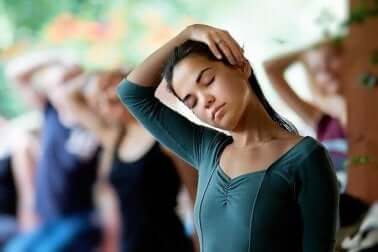Exercise Routines for Strengthening the Cervical Muscles


Written and verified by the doctor Karla Henríquez
Although this isn’t talked about much, the truth is that you need to strengthen your cervical muscles with certain exercises. Especially if you have an office job or a job that requires you to stay still for many hours.
Pain in the cervical muscles has become one of the most commonly consulted ailments in doctors’ offices and, many times, it’s due to poor posture.
To avoid this, there’s nothing better than doing stretching exercises and other activities that ensure their elasticity and increase muscle mass. In this article, we’ll teach you how to exercise the cervical muscles and some of the benefits of keeping this area in shape.
The benefits of exercises to strengthen cervical muscles
The cervical muscles not only interconnect with the back, but also contain a series of nerve impulses that lack of training can affect.
Strengthening exercises, such as those shown by a study published in the Journal of Pain Research, can help strengthen this area, minimizing the risk of injury and supporting the rehabilitation of existing ailments.
Likewise, doing these exercises regularly provides other benefits that we’ll discuss in detail below.
You should also read: Four Stretches that will Help Correct Your Posture
It helps to maintain balance
Basic motor movement, which is responsible for dynamic balance, need proper exercise. Keeping these muscles strong helps to prevent cervical vertigo.
It improves your breathing quality
Keeping the neck flexible has a big impact on respiration efficiency, especially when exercising. The muscles that play a role in respiration contract during physical activity and failing to train them enough can result in something we’re all familiar with: cervical pain.
It helps release stress
Cervical strengthening exercises help to release tension built-up from every day life. According to a study published in South African Journal of Physiotherapy, completing an strengthening session is great for eliminating neck-stiffness and for relaxing affected muscles.
Visit this article: 6 Habits that Cause Neck Pain
How to strengthen your cervical muscles
We need to keep our cervical muscles as flexible as they can be. In order to do so, you need an exercise routine that helps strengthen muscle tone. Following a proper exercise routine will prevent or lesson crippling contractures.
Our following recommended exercises will help you keep your cervical muscles flexible. Don’t forget to warm-up first.
Also, be sure to adopt a correct posture when you do them, as poor technique can worsen pain or cause injury.
If you have any doubts, it’s best to consult a coach or professional on the subject. Do you dare to try them out?

Exercise one. Forward stretch
- Sit upright, looking forward.
- Place your hands on your forehead and press on it while you push against your hand with the force of your head.
- Repeat 10 times.
Exercise two. Side stretch
- Similar to the previous exercise, place your hand on your temple as you try pushing against it with your head, feeling the push back.
- Continue the exercise, inclining your head until your ear almost reaches your shoulder.
- Follow with the other side.
- Repeat five times.
After warming up, continue with these exercises:
Exercise three
- Lower your head forwards, feeling the stretch in the back part of the neck.
- Hold the position for five seconds.
- Do the same thing backwards, leaning your head back as much as you can. Hold for five seconds.
- Rest 10 seconds.
- Repeat five times.
Want to know more? Read: 6 Best Exercises to Decrease Neck Pain
Exercise four
- Turn your head as if to look at your shoulder.
- Move your head slowly back to center.
- Look the opposite way.
- Repeat 10 times.
Exercise five
- Let your head slowly fall forward.
- Turn your head slowly towards the left, making a circular movement that brings your head back and to the right and, finally, to the starting position.
- Rest for five seconds.
- Repeat with the other side.
- Work each side five times.
Exercise six
- Without moving your head, raise your shoulders as if you wanted to use them to touch your ears.
- Hold this position for five seconds.
- After, lower your shoulders as much as you can.
- Hold for five seconds.
- Repeat 10 times, in both directions.
We must emphasize that these exercises are meant to be gentle and unhurried. Violent movements may cause sprains. Maintaining a strong neck is essential for enjoying a pain-free life.

Final tips
Bad posture, spending long periods of time in front of a computer, sleeping with an unsuitable pillow, and allowing stress to build up are triggers for cervical muscle problems.
- Take a well-deserved break, freeing your mind from everyday worries.
- Enjoy the benefits of a brisk walk by including it in your daily routine.
- Remember to use relaxation techniques, like deep breathing exercises in order to control stress.
All of the above, in addition to the exercises that we recommended, will positively impact your health.
All cited sources were thoroughly reviewed by our team to ensure their quality, reliability, currency, and validity. The bibliography of this article was considered reliable and of academic or scientific accuracy.
- Wilmore, J. H., Costill, D. L., & Gleim, G. W. (1995). Physiology of Sport and Exercise. Medicine & Science in Sports & Exercise. https://doi.org/10.1249/00005768-199505000-00024
- Suvarnnato T, Puntumetakul R, Uthaikhup S, Boucaut R. Effect of specific deep cervical muscle exercises on functional disability, pain intensity, craniovertebral angle, and neck-muscle strength in chronic mechanical neck pain: a randomized controlled trial. J Pain Res. 2019;12:915–925. Published 2019 Mar 7. doi:10.2147/JPR.S190125
- Falla, D., Jull, G., Russell, T., Vicenzino, B., & Hodges, P. (2007). Effect of Neck Exercise on Sitting Posture in Patients With Chronic Neck Pain. Physical Therapy. https://doi.org/10.2522/ptj.20060009
- Johnston, V., Jull, G., Souvlis, T., & Jimmieson, N. L. (2008). Neck movement and muscle activity characteristics in female office workers with neck pain. Spine. https://doi.org/10.1097/BRS.0b013e3181657d0d
This text is provided for informational purposes only and does not replace consultation with a professional. If in doubt, consult your specialist.








